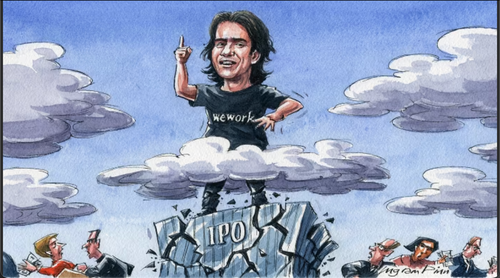
BREAKING: WeWork Bankruptcy CONTAGION RISK (Exposed)

The WeWork Domino: Dissecting the Implications for Global Real Estate and Banking
From the sun-soaked interiors of a villa in St. Barts, comes a narrative that extends far beyond the confines of leisure—a narrative that delves into the contagion risks stemming from the WeWork bankruptcy. The story unfolds through the lens of a live stream, where the Caribbean heat mirrors the intensifying pressure on the commercial real estate and banking sectors.

WeWork’s Bankruptcy: A Symptom of a Larger Malaise
The saga of WeWork’s bankruptcy is not merely about a company’s financial collapse but a symptom of systemic risks that have yet to be fully acknowledged by the market. With a significant footprint in global cities like London and New York, WeWork’s downfall could be the tremor that presages seismic shifts in the city’s office markets and beyond. While the immediate impact is confined to the U.S. and Canada, the ripple effects promise to be global. Anecdotal evidence from as far as Medellín suggests that WeWork’s struggle is not an isolated event but a harbinger of widespread challenges within the co-working space industry.
A Market at the Brink
The potential release of millions of square feet of office space onto the market, as in London, threatens to destabilize not just local real estate valuations but also the very foundations of commercial banking. With occupancy rates in flux, the implications for property valuations and the ability of landlords to service their debts are profound. This situation mirrors the liability side of Silicon Valley Bank’s balance sheet, where concentration in a single industry amplified risks manifold. Similarly, commercial real estate’s reliance on a few large tenants like WeWork could lead to a precarious position for landlords and their financiers.
The New Venture of Adam Newman
Amidst this backdrop, Adam Newman, the charismatic former CEO of WeWork, emerges with a new venture—Flow. Funded generously by venture capitalists, Flow claims to disrupt the largest asset class: residential real estate. However, the lack of clarity and concrete details around Flow’s business model raises red flags reminiscent of WeWork’s previous overpromises. A Bold Bet or a Reckless Gamble? In the dynamic and ever-evolving landscape of real estate investment, a new chapter is unfolding with Andre Horwitz’s staggering $350 million bet on Adam Newman’s latest venture. This move, echoing Newman’s previous success in the office space sector, raises a vital question: Is this a strategic investment or a perilous gamble preying on investor naivety?

The Strategy: Duping Investors with Residential Real Estate Behind closed doors, skepticism looms over the viability of Newman’s approach. The strategy appears to exploit investor psychology, leveraging fear of missing out (FOMO) and the pursuit of high yields. This approach, reminiscent of Newman’s past tactics, signals a potential repeat of history, suggesting a greater fool theory in play. Here, the investment’s success hinges not on its intrinsic value but on finding a succession of increasingly optimistic buyers.
The Disruptive Promise: Blurring Homeownership and Renting Newman’s new residential real estate play, touted as a tech business, promises to disrupt the world’s largest asset class. He proposes a hybrid model combining the benefits of apartment renting (flexibility) with those of homeownership (equity building). However, skepticism arises as the actual mechanics of this model remain vague. Newman’s pitch seems to be more about creating a “feeling” of homeownership rather than offering tangible equity, leading to doubts about its substance and viability. The Snake Oil Salesman: Repeating History with Different Packaging Comparisons are drawn to Newman’s past ventures, where a similar pattern of grand promises and minimal substance led to significant cash burn. The current strategy seems to be a repackaging of old models with new, trendy terminology. This approach, potentially deceptive in nature, raises red flags about the sustainability of the business model and its real value to investors.
Fast Company’s Confusion: Lack of Clarity in Newman’s Vision A recent event, as reported by Fast Company, highlighted the elusive nature of Newman’s new company, “Flow.” Despite an hour-long discussion by Newman, the actual business model and its unique selling points remained unclear, evoking comparisons to other infamous vague communicators in the business world.

The Four Pillars: An Ambiguous Foundation Newman’s outline of Flow’s business model rests on four pillars: technology, property management, real estate asset management, and financial services. However, each of these components, upon closer examination, seems either unoriginal or impractically ambitious. The promise of sharing value with “value creators” turns out to be more about perceived value than actual equity sharing, further muddling the business’s true nature.
Navigating the Hype with Caution As we assess the current economic cycle, the emergence of ventures like Newman’s signals that we might still be closer to a market peak than a trough. The presence of such speculative ventures, reminiscent of pre-2008 conditions, should serve as a cautionary tale. Investors are urged to prioritize fundamentals over hype and to remain vigilant against the seductive narratives of modern-day “snake oil” salesmen. As the real estate market continues to evolve, distinguishing between genuine innovation and cleverly marketed mirages remains crucial. In closing, the Newman case underlines the importance of investor education and the need for a critical evaluation of investment opportunities. It’s a reminder for investors to uphold the principles of freedom, liberty, and free-market capitalism, ensuring a healthy, transparent, and fundamentally sound investment landscape.
